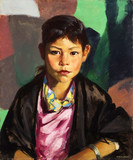A highly successful portraitist and figure painter, Robert Henri was also extremely influential as a teacher and leader of progressive artists during the early years of this century. Robert Henri was born Robert Henry Cozad. Because his father feared reprisals after a shooting in self-defense, the family fled in 1882 to Denver, Colorado, and later Atlantic City, New Jersey, assuming various names. At the age of twenty Henri entered the Pennsylvania Academy of the Fine Arts in Philadelphia, where he studied with Thomas Anshutz (1851-1912). In 1888 he left with some friends from the academy to seek further training in Paris at the Académie Julian. In 1891 he returned to Philadelphia, studying again at the academy, this time with Robert Vonnoh (1858-1938).
Henri’s long career as one of the country’s most influential art teachers was begun there the following year. He emerged during this period as the leader of a group of young artists and spokesman for progressive approaches. With William Glackens (1870-1938) he left Philadelphia and went to Paris again in 1895. Two years later he returned to Philadelphia, held a successful solo exhibition, married, and left again for Paris in 1898 for another two years. In 1900 he settled in New York, his home for the rest of his life. Henri resumed teaching, joining the faculty of the New York School of Art in 1903, and turned his attention to portraiture. He met with considerable success, winning election to the Society of American Artists in 1903 and the National Academy of Design as an academician in 1906. Continuing to champion progressive art, in 1908 he helped organize the exhibiting group The Eight, which caused a sensation with its boldly painted, frank portrayals of life in New York. That same year he established his own school of art, which remained open for five years. His first wife died in 1905, and he remarried in 1908. He continued to live in New York but traveled extensively, especially during the summer, to Maine, Holland, Spain, Ireland, the Southwest, and other places.
In the autumn of 1914 Henri had a solo exhibition at the recently founded Los Angeles Museum. He taught almost every year through 1928 at the Art Students League, inspiring a generation of young painters. He taught them a solid technique but also the importance of expressing their individuality. His lectures were published posthumously as The Art Spirit (1939). He died in New York, where he was honored with a memorial exhibition at the Metropolitan Museum of Art.
BIBLIOGRAPHY
New York, Janet Le Clair Collection, Robert Henri Papers (portions on microfilm, Archiv. Am. Art) § E. Ralph Cheyney, "The Philosophy of a Portrait Painter: An Interview with Robert Henri," Touchstone 5 (June 1919): 212-19 § Index 20th Cent. Artists 2 (January 1935): 49-60; 2 (September 1935): I; 3 (AugustSeptember 1936): III; reprint, pp. 311-22, 327, 329 § William Innes Homer, Robert Henri and His Circle (Ithaca, N.Y.: Cornell University Press, 1969), with the assistance of Violet Organ, with bibliography § Wilmington, Delaware Art Museum, and others, Robert Henri, Painter, exh. cat., 1984, with essay by Helen Farr Sloan, catalogue by Bennard B. Perlman, epilogue by Rowland Elzea, chronology, bibliography.



